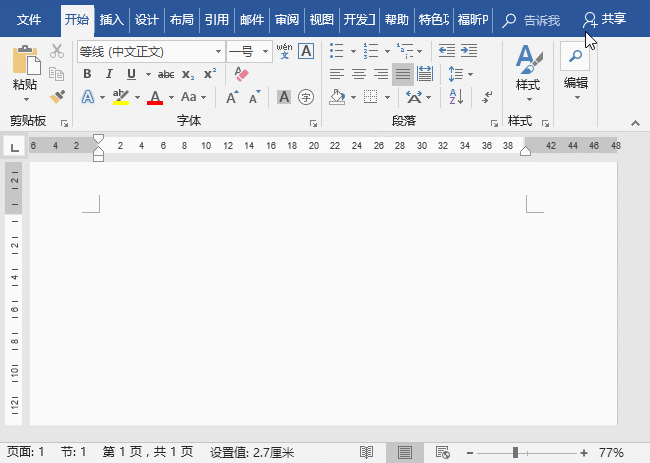In the previous article "Practical Word Tips Sharing: 5 Ways to Clear All Formatting", we learned 5 ways to clear all formatting in word. Today we are going to talk about a summary of quick entry skills in Word, come and take a look!

At work, we often use Word. When using Word, the most basic operation is to enter a variety of text. For example, sometimes we need to enter uppercase numbers, rare words, special symbols, formulas, etc.....
If you don't know these simple input skills, your work efficiency will always be very low. Therefore, today I have summarized a number of Word input tips for you, and learning them can double your work efficiency.
1. Word case conversion of numbers
First, enter the number "123456", then select the number and click [Insert]-[Symbol] 】-[Numbering] button to open the "Numbering" dialog box, and select the uppercase number "One, Two, Three..." option in the "Numbering Type" list box.

2. Convert Word simplified characters to traditional Chinese characters
After entering the text, select the text and click [Review] 】-[Chinese Simplified and Traditional Conversion]-[Traditional and Simplified Conversion] button.

3. Enter the ellipses
In the Chinese input state, directly Press the [Shift 6] key combination or press the [Ctrl Alt .] key combination to enter an ellipsis. The "6" here is the numeric key 6.

4. How to type uncommon words in Word
Nowadays, I believe that the vast majority of office workers Pinyin input method is used to enter text. What should we do if we cannot spell when we want to enter a text that we cannot read?
In fact, we can enter the text through the Word insertion symbol method. For example, we need to enter "唟".
First, enter the word "口" in Word and select it, then click the [Insert]-[Symbol]-[Other Symbols] command, and set the "Font" to "Normal Text" in the dialog box that opens. ", the "subset" is "CJK Unified Chinese Characters", you can see many Chinese characters with the radical "口", and just find the text you need.

5. Enter special symbols
when writing materials or making plans , it is always inevitable to enter some special symbols, what should I do?
(1) Special symbols
If we need to enter symbols such as ticks, crosses or ticks in boxes in Word, we can also click [ Insert]-[Symbol]-[Other Symbols] command, set the "Font" to "Wingdings2" in the opened dialog box, you can see many symbols, find the required symbol and click to input.

(2) Trademark symbols
If we want to enter trademark symbols, such as: ™, ®, ©, etc.. ....You can quickly input directly through shortcut keys.
Click the [Insert]-[Symbol]-[Other Symbols] command, and set the "Font" to "Wingdings2" in the dialog box that opens. You will be able to see many symbols and find the symbols you need. Click to enter.
You can also use shortcut input: TM trademark: shortcut key [Alt Ctrl T]: R trademark: shortcut key [Alt Ctrl R]: copyright symbol: the shortcut key is [ Alt Ctrl C].
6. Enter superscript and subscript in Word
First enter the text, for example, enter O2, and then select 2. Then click the superscript symbol and subscript symbol in the [Font] group.
7. How to enter scores in Word
Many friends use slashes when entering fractions in Word. In fact, in documents with strict specificity requirements, such input does not comply with the specifications. So how to enter professional fraction expressions?
Method 1: Position the mouse cursor to the location where the score needs to be entered, and then press the [Ctrl F9] key combination. At this time, a pair of braces will appear. We enter " EQ F(4,9)" (note: there is a space between EQ and the slash), right-click the field and select the "Switch Field Code" command in the pop-up menu to see the score effect.
Method 2: Click the [Insert]-[Symbol]-[Formula] button, select the "Insert New Formula" command, and click "Structure" button, select "Fraction" in the pop-up list, and enter data one by one on the numerator and denominator.
Recommended tutorial: "Word Tutorial"
The above is the detailed content of Practical Word skills sharing: upper and lower case numbers, converting to traditional Chinese characters, typing uncommon characters, fractions, superscript and subscript input. For more information, please follow other related articles on the PHP Chinese website!
 How to change word background color to white
How to change word background color to white
 How to delete the last blank page in word
How to delete the last blank page in word
 Why can't I delete the last blank page in word?
Why can't I delete the last blank page in word?
 Word single page changes paper orientation
Word single page changes paper orientation
 word to ppt
word to ppt
 Word page number starts from the third page as 1 tutorial
Word page number starts from the third page as 1 tutorial
 Tutorial on merging multiple words into one word
Tutorial on merging multiple words into one word
 word insert table
word insert table